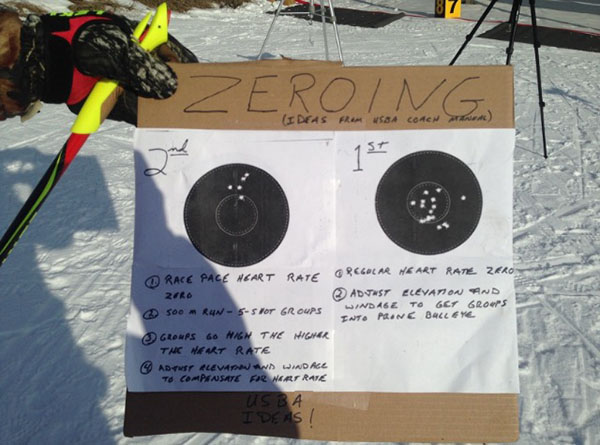By Erin Barney
Breathe in. Exhale halfway. Hold it. Ignore pulsing temples, burning muscles, and the crack of an adjacent rifle. Focus. Pull the trigger.
In a moment requiring absolute stillness, Olympic biathlete Lowell Bailey said it’s rarely quiet enough in his head to achieve the necessary Zen. He has to hit a four-and-a-half-inch target 160 feet away, fully distracted by his body and surroundings. Then, without a pause to regroup, he takes off for another lap on skis.
The unlikely paring of competitive shooting and cross-country ski racing form the biathlon—a Winter Olympic event since 1960. Biathletes strap a .22 caliber rifle to their backs and race around a trail system. They make four stops at a shooting range, one after each lap, and get five shots at a line of five metal targets. There is a time penalty for each missed target.
Skiing fast and shooting straight appears challenging enough, but the true difficulty of the sport isn’t visible to a spectator. During the transition between skis and a rifle, everything beneath a biathlete’s skin and inside his head is working in favor of a misfire.
At the BMW IBU World Cup Biathlon in Canmore, Canada last weekend, Bailey missed two shots and a top-20 finish in the 10km sprint by only a few millimeters.
“You can’t survive at the World Cup or Olympics if you’re just good at one of those things,” Bailey said. “You have to be fast and accurate.”
Much easier said than done. Biathletes like Mark Torresani, president of the Blackhawk biathlon club in Wisconsin, rely on tight, mechanized routines to shave seconds. Torresani unslings his rifle while dropping into a prone position on the shooting mat. He also tucks his ski poles under his right leg so they are directly beneath his hand when he’s ready to stand back up.
Most competitors spend less than 20 seconds at the range during a race, only taking a breath and a half between shots. But it’s a delicate process—keep it in too long, oxygen deprivation causes blurry vision. Let it out, and waste valuable seconds re-steadying.
Dr. Kannan Mutharasan, a sports cardiologist with the Northwestern Medical Group, said the abrupt stop on the mat puts biathletes at risk for fainting. They have to flex large muscles in their legs or abdomen to prevent blood from pooling.
“It’s like driving a car,” Mutharasan said. “Once the gas is on, the system won’t tolerate suddenly slamming on the breaks.”
The thumping of a fully-exerted cardiovascular system poses another problem. Bill Wucherer, a Wisconsin biathlete, said when he lines up his shot, his pulse throbs even in his fingertips. That pounding causes microscopic flinching—movements invisible to a spectator, but detrimental to his accuracy. Shot clusters physically rise about an inch as the heart rate goes up.
“We don’t even bother trying to slow down anymore,” Wucherer said. “It’s about zeroing your shot despite hearing and feeling your blood move like that.”

Bailey said European biathletes have recently abandoned any attempt at body control, and instead just learned to shoot off-balance. Top biathletes might spend 15 hours each week with a sports psychologist like Dr. Jim Taylor, working toward a clear head to compensate for a trembling hand.
Taylor has been a consultant for the US ski team, and now helps athletes worldwide achieve mental clarity. He said biathletes are mainly distracted by the clock, especially when their opponents are quicker in-and-out of the the range. Taylor said he tries to prevent in-race panic by having biathletes visualize accurate shots before the shotgun start.
With all competitors in peak physical condition, Bailey said sometimes having a slight mental edge is the only way to win.
“All of a sudden, we’ve seen guys who shoot 95 and 100 percent regularly and are doing it in a much shorter time period,” Bailey said. “That’s been the hardest thing for me to adapt to over the past few years.”
Though US biathletes have been adopting the newest versions of the sport, Bailey said they still trail the Europeans at nearly every competition. The United States has never medaled at the Olympics, and true to form, finished fourth behind Norway, Italy and Germany in the mixed relay at the IBU World Cup. They missed the bronze by less than two seconds.
“It’s like taking a free throw, or a golf swing or anything like that,” Bailey said. “But if you talk to any professional athlete who is in those sports, the biathlon is no different. Once you get to a certain level, it’s all about the mental game.”


